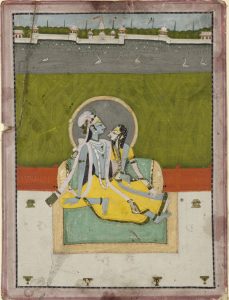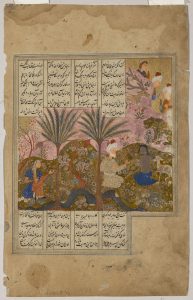Iran, Shiraz. c. 1560 CE
Majnun Visited by His Father in the Desert
Folio from a manuscript of the Khamsa (Quintet) of Nizami Ganjavi (1141-1209)
Ink, opaque watercolors, and gold on paper
Gift of Elinor Lander Horwitz, class of 1950
SC 2016:29-24
This figurative painting depicts a scene from the Persian poem Layla and Majnun, a story of love and longing.
Layla and Qays fell in love as children but Layla’s father prevents them from being together. Qays gains the nickname Majnun (Madman) because of how obsessively he loves Layla. Layla marries someone else and Majnun secludes himself in the desert.
Pictured here, Majnun’s father visits his son. Since Majnun has been wandering in the wilderness, pining for Layla, his skin appears to be very tanned. We see palm trees and animals: a deer, lion, antelope, and snake, who were Majnun’s companions.
The accompanying 18th-century Indian painting depicts a love scene between the Hindu divinities Krishna and Radha. Though visually and culturally different, these paintings and stories relate the mystical power of love within human and divine beings.
Annie Titan, Smith College ‘20
India, Kishangarh. Late 18th CE
Krishna and Radha
Ink, opaque watercolors, and gold on paper
Gift of Elinor Lander Horwitz, class of 1950
SC 2016:29-7
Majnun Visited by His Father in the Desert
[Detailed Image Description: This painting depicts two main figures in the wilderness; one has pale skin and is wearing a white and red turban and yellow-cream outfit with small brown spots. He is kneeling on the ground with his arms outstretched to the figure sitting on his right, who is portrayed with much darker skin. There are no details on his face. He is wearing a bright blue skirt and no top. Along with these two main figures is a female figure to their left who may be picking some kind of plant or observing flowers from a thin palm tree. She wears a blue dress with red-orange and green-flowered sleeves and is carrying a bag with the same colors. Three other male figures are in the top-right hand plane of the painting, two of whom are peering outside of the canvas. Various animals of an antelope, deer, lion, and snake surround each figure. The sky is gold, the undulating hillside is light pink, and the ground the figures are sitting on is dark brown-gold. The painting itself is arranged into a backward L-shape with four blocks of Arabic calligraphic poetic text on the top and bottom of the painting. A “border” of many ultra-fine lines of blue, gray, and gold ruling are placed around the painting.]
Krishna and Radha
[Detailed Image Description: This painting is of two seated figures with dark black hair. The man and woman sit on a beige and teal-colored throne. The man on the left is wearing an elegant light-pink turban with green and white accents. Both figures have light blue skin, yellow makeup, and are wearing extravagant white, pink, and green jewelry and yellow skirts. The lovers’ lanky arms and legs are spread out away from their bodies but they are leaning into and gazing at each other. Behind the figures is a sectioned-off background: at the top are cream and salmon-colored architectural elements bounded by green trees, and white birds that stand on a gray-colored ground. Below that is a large olive-green rectangular section which the figures bodies’ occupy, followed by a bright salmon colored strip with vertical geometric designs lightly painted on, and a grey-white area on the bottom of the painting with small green and brown ceramics distributed evenly around. The whole painting is surrounded by a thick pink-purple border on the outside and thin black striped border on the inside.]
